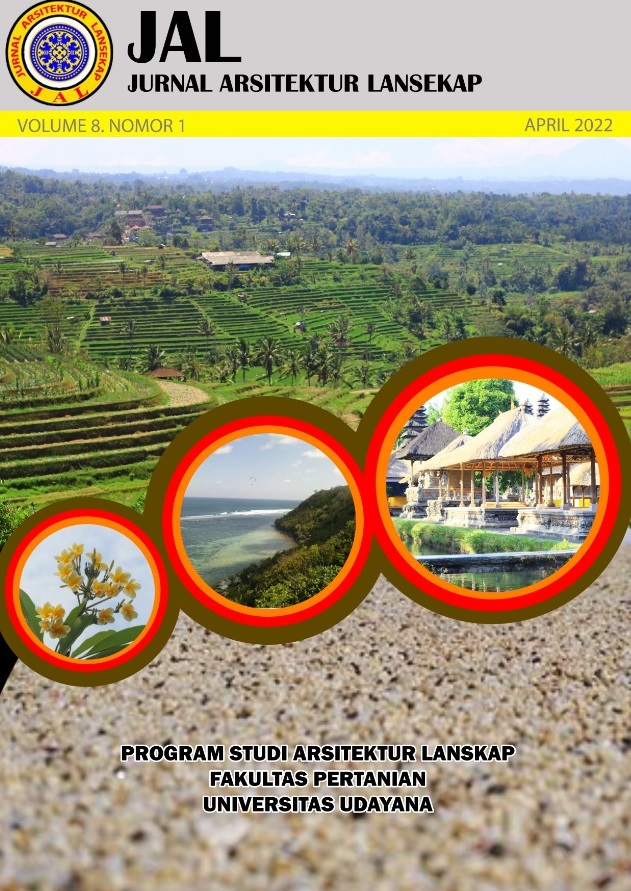Analisa Implementasi Rancangan Responsif Iklim pada Penginapan Firefly Eco-Lodge di Ubud, Bali
Abstract
Climate responsive design implementation study at Firefly Eco-Lodge in Ubud, Bali. Indonesia is included in the tropical climate zone, namely tropical wet with a focus of 2 seasons, namely the rainy and dry seasons. Climate is a challenge that is part of the daily scope of activities. One of the studies included in it is the architectural aspect. Architecture itself is a design that associated with residential function where lodging as a place as a temporary residential as secondary function with the main focus of relaxation and recreation. Implementation of climate-responsive architecture need an effort to meet the needs and comfort of the community as users while also maintaining aesthetic and ecological principles. This study aims to understand the implementation of climate responsive architectural studies in lodging units and to determine the study of climate responsive architectural elements in lodging facilities. Found that building form, building layout, open plan room, landscaping, and material used are the key factor of climate responsive design that applied in Firefly Eco-Lodge. Circle & rounded shape created minimum solid surface exposed by solar radiation. Open plan concept creates natural wind flow that maintained comfort humidity. The method used is descriptive qualitative, which analyzes using climate-responsive architectural studies. Climate responsive principles implemented that meet with climate issues, such as solar radiation and thermal comfort, rainfall, air circulation, building shape, and the application materials and landscape that accommodate tropical climate issues.
Downloads
References
Allaby, M. (2002). Encyclopedia of Weather and Climate (Resived Ed). Facts On File, Inc. Publishing.
Arsad, E. (2015). Teknologi Pengolahan dan Manfaat Bambu. Jurnal Riset Industri Hasil Hutan, 7(1), 45–52.
Artiningsih, N. K. A. (2012). Pemanfaatan Bambu pada Konstruksi Bangunan Berdampak Positip bagi Lingkungan. Metana, 8(1). https://doi.org/https://doi.org/10.14710/metana.v8i01.5117
Boutet, T. S. (1987). Controlling Air Movement : A Manual for Architects and Builders. McGraw-Hill Book Company.
Broadbent, G. (1973). Design in Architecture: Architecture and the Human Sciences (Wiley-Blac). John Wiley & Sons.
Cowan, S., & Ryn, S. V. D. (1996). Ecological Design. Island Press.
Egan, M. D. (1975). Concept in Thermal Comfort. Prentice- Hall Inc.
Femy, Budiarti, T., & Nasrullah, N. (2017). Pengaruh Tata Hijau Terhadap Suhu Dan Kelembaban Relatif Udara, Pada Balai Besar Pengembangan Mekanisasi Pertanian, Serpong. Jurnal Lansekap Indonesia, 6(2), 21–28. https://doi.org/10.29244/jli.2014.6.2.21-28
Handoko, J. P. S., & Ikaputra. (2019). Prinsip Desain Arsitektur Bioklimatik Pada Iklim Tropis. Langkau Betang: Jurnal Arsitektur, 6(2), 87–100.
Hermawan, M. R. (2020). Penerapan Tema Tanggap Iklim Melalui Pendekatan Arsitektur Tropis Pada Perancangan Rumah Susun Sederhana Sewa (RUSUNAWA) Di Kota Banda Aceh. Jurnal Ilmiah Mahasiswa Arsitektur Dan Perencanaan, 4(3), 22–26.
Hyde, R. (2013). Climate Responsive Design. Taylor & Francis. https://doi.org/https://doi.org/10.4324/9781315024905
Imran, M. (2013). Pengaruh Iklim Terhadap Bentuk dan Bahan Arsitektur Bangunan. RADIAL: Jurnal Peradaban Sains, Rekayasa Dan Teknologi, 1(1), 1–10.
Kukreja C. P. (1978). Tropical Architecture. Tata McGraw-Hill Publishing Company.
Kurnia, A. S. (2013). Eksplorasi Material Lokal Untuk Menjawab Tantangan Arsitektur Global : Optimalisasi Pemanfaatan Bambu. SCAN : Ilmu Dan Teknologi Material Bangunan, 4(2), 18–32.
Looman, R. (2017). Climate- Responsive design: A Framework for an energi concept designdecision support tool for architects using principles of climate-responsive design. A+BE/ Architecture and the Built Environment, 1. https://doi.org/DOI: 10.7480/abe.2017.1
Mahgoub, Y. (2007). Architecture and the Expression of Cultural Identity in Kuwait. Journal of Architecture, 12(2), 82–165. https://doi.org/https://doi.org/10.1080/13602360701363486
Muchamad, B. N., & Ikaputra. (2010). Model Ekspresi Arsitektur. Menuju Pendidikan Arsitektur Indonesia Berbasis Riset, 2, 39–46.
Nugroho, I. (2011). Ekowisata dan Pembangunan Berkelanjutan (1st ed.). Pustaka Pelajar.
Olgyay, V. (1992). Design With Climate: Bioclomatic Approach to Architectural Regionalism. Princeton University Press.
Pebriyanti, N. L. P. E., & Laskara, G. W. (2016). Evaluasi Kualitas Elemen Dan Redesain Interior Fasilitas Kampus Di Fakultas Teknik Arsitektur Universitas Udayana. Seminar Nasional Sains Dan Teknologi (SENASTEK III).
Prasetyo, Y. H., & Astuti, S. (2017). Ekspresi Bentuk Klimatik Tropis Arsitektur Tradisional Nusantara Dalam Regionalisme. Jurnal Permukiman, 12(2), 80–94.
Prijotomo, J., & Adiyanto, J. (2004). Arsitektur Nusantara: Menuju Keniscayaan. Wastu Lanas Grafika.
Setyohadi, R. M. B. (2011). Kajian Kenyamanan Thermal Pada Bangunan Rumah Tinggal Arsitektur Kolonial Modern. Jurnal Teknik Dan Perencanaan, 1(13), 9–20.
Sukawi, W. (2008). Ekologi Arsitektur: Menuju Perancangan Arsitektur Hemat Energi dan Berkelanjutan. Simposium Nasional RAPI VII.
Sung, C. K., & Kyung, W. S. (2014). The Architectural Expression of Space and Form Created by the Light in the Works of Alvaro Siza. Journal of Building Construction and Planning Research, 2(2), 31–118.
Taaluru, S. Y., & Siregar, F. O. P. (2012). Ekspresi Material Pada Selubung Ruang Sebagai Media Hadirnya Pengalaman Arsitektur. Jurnal Media Matrasain. Department of Architecture, Engineering Faculty-UNSRAT., 9(2).
Ven, C. V. D. (1987). Space in Architecture (Third Edit). Van Gorcum.
Wirartha I. M. (2006). Pedoman Penulisan Usulan Penelitian, Skripsi dan Tesis. Andi.
Yuwono, B. (2007). Pengaruh Orientasi Bangunan Terhadap Kemampuan Menahan Panas Pada Rumah Tinggal Di Perumahan Wonorejo Surakarta. Universitas Diponegoro, Semarang.

This work is licensed under a Creative Commons Attribution-ShareAlike 4.0 International License.
An author who publishes in the Jurnal Arsitektur Lansekap (JAL) agrees to the following terms:
- Author retains the copyright and grants the journal the right of first publication of the work simultaneously licensed under the Creative Commons Attribution-ShareAlike 4.0 License that allows others to share the work with an acknowledgement of the work's authorship and initial publication in this journal
- Author is able to enter into separate, additional contractual arrangements for the non-exclusive distribution of the journal's published version of the work (e.g., post it to an institutional repository or publish it in a book) with the acknowledgement of its initial publication in this journal.
- Author is permitted and encouraged to post his/her work online (e.g., in institutional repositories or on their website) prior to and during the submission process, as it can lead to productive exchanges, as well as earlier and greater citation of the published work (See The Effect of Open Access).
Read more about the Creative Commons Attribution-ShareAlike 4.0 Licence here: https://creativecommons.org/licenses/by-sa/4.0/.







